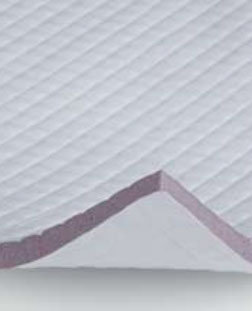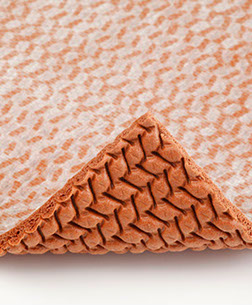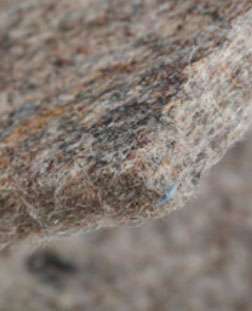Cushion
Urethane Foam
Prime Polyurethane Foam is a firmer version of the same cushioning used in upholstered furniture, mattresses, and automobile seats. Two liquid ingredients are combined to form a large mass of foam, which is then sliced into sheets for use as carpet cushion.
Bonded Polyurethane Foam (sometimes called rebond) is quite unique. You cannot mistake it when you see it, because it is formed by combining chopped and shredded pieces of foam, in different sizes and usually different colors, into one solid piece. It frequently has a surface net for ease of installation and improved performance.
Bonded Foam is one of the most amazing recycling projects of all time. Nearly all the scrap foam in the U.S., and some from other countries as well, is utilized to make bonded cushion. This recycles waste, which would otherwise be thrown out, and it eases the strain on our landfills. Moreover, bonded foam is itself recyclable.
Froth Polyurethane Foam is made with carpet backing machinery. Liquid ingredients are applied, either directly to the backs of some carpet styles, or to a non-woven material (for making separate cushion). They react and form a thin, dense foam which is particularly useful in commercial applications with wide expanses of carpet.
Rubber
Waffled Rubber Cushion is made by molding natural or synthetic rubber. Heat cures the rubber and forms a waffle pattern. This variety produces a soft, resilient cushion whose luxurious feel is particularly useful for residences.
Flat Sponge Rubber is a firm, dense cushion, which has a flat surface and is normally used in large-scale commercial applications and with loop type (or Berber) carpet.
Fiber
Synthetic Fibers include nylon, polyester, polypropylene, and acrylic, which are needle-punched into relatively dense cushions which have a firm feel and, as with other types of cushion, can be made in virtually any weight, to stand up under light, medium, or heavy traffic, which is how they are usually classified.



History of Carpet Cushion
In the early twentieth century, Americans placed carpet cushion beneath area rugs for added comfort underfoot and increased insulation. Eventually, carpet cushion use was expanded as homeowners took advantage of its inherent thermal qualities for increased insulation.
Some of the first carpet cushion was made from cattle hair, obtained as a by-product of the leather tanning process, because of its great resilience and durability. However, between the 1930s and 1950s, the tremendous growth of the tufted carpet industry caused an increase in carpet production, which exceeded the availability of cattle hair. Gradually, hair carpet cushion became a mixture of the jute plant because its qualities were similar to those of cattle hair. Today, this natural fiber underlay of hair and rubberized jute comprises about 2 percent of the current carpet cushion market.
Synthetic carpet cushion, also part of the fiber cushion family, is made by needlepunching off-grade carpet fibers. Although synthetic carpet cushion use has experienced rapid growth over the last three decades, it constitutes about 5 percent of the current carpet cushion market.
After World War II -- to meet the burgeoning demand for tufted carpet -- sponge rubber carpet cushion emerged. Made from natural rubber or styrene and butadiene rubber developed by tire companies during the war, sponge rubber is, by definition, an elastic porous mass with interconnecting cells obtained by combining rubber with blowing agents under heat-intense conditions. This gives the cushion its sponge-like effect. Today, three plants in the United States manufacture sponge rubber carpet cushion, totaling about 4 percent of the carpet cushion market.
The remainder of today’s carpet cushion business in the United States belongs to polyurethane foam -- both prime and bonded -- mainly because of its versatility, permitting it to be used in the manufacture of prime, graft, densified, bonded, and mechanically frothed carpet cushion. Each year, around 700 million pounds of polyurethane foam trim is gathered from all over the world from the manufacture of such items as sofas, chairs, mattresses, automotive interiors (i.e. door panels, seat cushions, etc.), textiles and clothing. This polyurethane foam trim is compressed, baled and transported to approximately 30 U.S. factories where it is recycled into bonded carpet cushion, making it one of the largest uses of recycled materials in the world.


